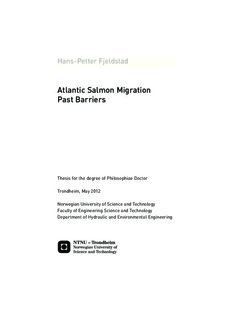| dc.contributor.author | Fjeldstad, Hans-Petter | nb_NO |
| dc.date.accessioned | 2014-12-19T12:31:31Z | |
| dc.date.available | 2014-12-19T12:31:31Z | |
| dc.date.created | 2012-07-02 | nb_NO |
| dc.date.issued | 2012 | nb_NO |
| dc.identifier | 538854 | nb_NO |
| dc.identifier.isbn | 978-82-471-3538-9 (printed ver.) | nb_NO |
| dc.identifier.isbn | 978-82-471-3539-6 (electronic ver.) | nb_NO |
| dc.identifier.uri | http://hdl.handle.net/11250/242176 | |
| dc.description.abstract | The Atlantic salmon depend on successful migration between essential habitats in freshwater and the ocean. However, during both downstream and upstream migration the fish encounter natural or manmade obstacles which can block or delay their migration and migration through hydropower turbine can cause severe mortality. This PhD-study has focused the salmon migration challenges, upstream and downstream, based on studies in Norwegian rivers, and the results are presented in four scientific papers. A study of all the 344 Atlantic salmon fishways in Norway was conducted to investigate the state and function of the fishways and to identify links between passage efficiency and physical characteristics of the construction and the river site. The results showed that 66 % of the Norwegian fishways were passing fish effectively. No correlation was found between fishway functionality and their height, length or technical design. Functional fishways were found at river sites with larger discharge than dysfunctional fishways and efficiency was better among fishways passing man-made obstacles. These findings indicate that fishways in smaller rivers and fishways without supervision and funding from hydropower companies suffer from lack of sufficient attention. While entrance design problems are reported to be a main challenge in many fish pass projects, this was not the same situation among Norwegian fishways. On the other hand, many fishways were not functional because of long time lack of maintenance or damages from physical strain. Downstream migration of juvenile Atlantic salmon past a hydropower intake in a Norwegian river was studied by use of radio tagged fish during three spring seasons. The results showed that it was possible to create models for both the smolt timing and for the route choice at the intake, where the fish could enter the intake or choose a bypass section. Route choice was controlled by both total river discharge and proportion of discharge in the bypass. Additionally, a model could be developed to describe the effect of strobe lights at the intake. This model demonstrated that more fish chose the bypass when the strobe lights were on during night, while no such effect was found during daytime. Further, a hydropower simulation model was calibrated for the same river. By use of this model, it was shown that river discharge and partition could be optimized to increase bypass migration according to the route choice model. Both reservoir manipulation and manipulation of discharge partition at the intake was simulated and showed that bypass migration could be increased from 20 to 80% in selected years. The use of models to describe downstream migration represents a useful tool for planning of fish-friendly hydropower production and the methods are most likely applicable to other rivers and regions. In a case study of man-made weirs on a residual flow river reach the delaying impact from the weirs on upstream migration was studied. Adult Atlantic salmon were enumerated in an upstream fish ladder before and after removal of two concrete weirs. The point of time for peak migration was more than one month earlier after the removal, indicating that even small obstacles may imply significant migration delay. Additionally, the weir removal changed the physical habitat from a lake habitat to a riverine habitat. Consequently, a large increase in spawning and subsequent juvenile densities was observed immediately after restoration. | nb_NO |
| dc.language | eng | nb_NO |
| dc.publisher | Norges teknisk-naturvitenskapelige universitet, Fakultet for ingeniørvitenskap og teknologi, Institutt for vann- og miljøteknikk | nb_NO |
| dc.relation.ispartofseries | Doktoravhandlinger ved NTNU, 1503-8181; 2012:128 | nb_NO |
| dc.relation.haspart | Fjeldstad, H. P.. Atlantic salmon fishways: The Norwegian experiences. . | nb_NO |
| dc.relation.haspart | Fjeldstad, Hans-Petter; Uglem, Ingebrigt; Diserud, Ola Håvard; Fiske, Peder; Forseth, Torbjørn; Kvingedal, Eli; Hvidsten, Nils Arne; Økland, Finn; Järnegren, Johanna. A concept for improving Atlantic salmon smolt migration past hydro power intakes. Journal of Fish Biology. (ISSN 0022-1112), 2012. <a href='http://dx.doi.org/10.1111/j.1095-8649.2012.03363.x'>10.1111/j.1095-8649.2012.03363.x</a>. | nb_NO |
| dc.relation.haspart | Fjeldstad, H. P; Alfredsen, K.; Boissy, T.. Optimizing Atlantic salmon smolt survival by use of hydropower simulation modelling in a regulated river. . | nb_NO |
| dc.relation.haspart | Fjeldstad, Hans-Petter; Barlaup, Bjørn Torgeir; Stickler, Morten; Gabrielsen, Sven Erik; Alfredsen, Knut. Removal of weirs and the influence on physical habitat for salmonids in a Norwegian river. Rivers Research and Applications - an international journal devoted to river research and management. (ISSN 1535-1459), 2012. | nb_NO |
| dc.title | Atlantic Salmon Migration Past Barriers | nb_NO |
| dc.type | Doctoral thesis | nb_NO |
| dc.contributor.department | Norges teknisk-naturvitenskapelige universitet, Fakultet for ingeniørvitenskap og teknologi, Institutt for vann- og miljøteknikk | nb_NO |
| dc.description.degree | PhD i vann- og miljøteknikk | nb_NO |
| dc.description.degree | PhD in Hydraulic and Environmental Engineering | en_GB |

